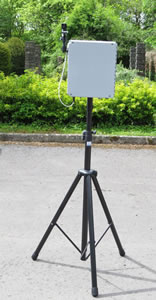JammerCam puts crime in picture
Following successful trials, a GPS jammer-triggered camera system is set to become the latest tool in the fight against organised crime groups engaged in vehicle and plant theft.
Global positioning system (GPS) signals are now integrated into many critical infrastructure organisations for positioning, navigation and timing applications, including defence, policing, security, transport and marine.
However, this GPS signal is susceptible to outages due to intentional and unintentional jamming and intentional jamming is on the increase and now recognised as a clear and present threat.
GPS jammers are being actively used by criminals to disable GPS-based tracking technology to steal a car or a high-value asset. Lorry hijacking is increasingly undertaken with GPS jammers to ensure that the fleet tracker personnel cannot see the targeted vehicle, while some serious crime gangs use jammers to disable covert tracking technology. Jamming technology can also be used to disable offender GPS tagging devices.
The Governments innovation agency Innovate UK research project Sentinel which includes partners from Ofcom, the Centre for the Protection of National Infrastructure, the University of Bath, law enforcement agencies and GPS jamming detection and location specialist Chronos Technology has identified more than 60 (non-UK) websites selling jammers, some as low as £30, ranging from small low-cost portable and in-car devices to major military application devices.
Professor Charles Curry, founder and managing director of Chronos Technology, said: The use of GPS jammers is now extremely prevalent in organised crime, especially in the theft of high-value vehicles and plant, and the evasion of covert and tagged tracking devices.
Government supported research from Innovate UK, the UKs Innovation Agency within the Department for Business Innovation and Skills, has now enabled new technology to be developed to detect GPS jammers and assist the UKs fight against organised crime.
Chronos has created a wide range of GPS jammer-detection solutions, from handhelds with direction-finding capability to mesh networks, which geolocate a jammer in real time. To optimise the technology for organised crime applications, Chronos has been working closely with Hampshire Constabulary, which sees it as a significant development in the effort to provide actionable intelligence to frontline officers in the fight against vehicle and plant theft.
We are particularly excited about our latest innovation, JammerCam, which triggers a photo trap as a vehicle passes carrying a jammer. It then puts the image of the vehicle on your phone within seconds, said Professor Curry.
The JammerCam, developed by Chronos under an Innovate UK-supported collaborative research project, Automatic Jamming Recognition (AJR), with the University of Bath Department of Electronic and Electrical Engineering, detects a single feed based on vehicles passing in front of a remote detector; this then communicates a photograph to a central server. A smartphone user can then access the photograph of the car with the jammer in near real-time.
Professor Curry said that while solutions have been developed for the simple detection of GPS jammers, the technology to trigger a camera from a passing car with a GPS jamming device is not trivial.
The JammerCam was successfully tested during the recent official GPS jamming trials at the Sennybridge military training area in Wales.
The trials allowed JammerCam units to be trialled in an open air environment with a range of GPS jammers hidden in vehicles passing by singly and in convoys, including cars, vans and shipping containers. The jammer-triggered camera sensor technology successfully identified and photographed the jammer-hosted vehicle in every test case and at all speeds and powers. In all cases, the vehicle was caught in the centre of the frame so only a single picture was needed, considerably reducing the amount of bandwidth needed between the sensor and the web server.
The photograph identifying the vehicle with a jammer would then be sent via a mobile network to a web server and distributed as a hyperlink to target email addresses. The picture can then be c





